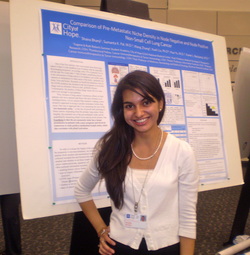|
8/4/2011 0 Comments No Such Thing as "Game Over"One of the first statistics that most people hear about lung cancer is that it is the deadliest type of cancer with an especially discouraging prognosis: on average, only 15% of patients live to tell the tale five years later. (1,2).
* * * During my time spent conducting research and seeing patients, I've not only learned that lung cancer is the leading cause of cancer death, but I've also seen why; the reason comprises of a number of factors, one of which is likely metastasis to the brain, liver and bones. Our research project, entitled Comparison of Pre-Metastatic Niche Density in Node Negative and Node Positive Non-Small Cell Lung Cancer, was, in the most general terms, an effort to find a way to predict metastases before they occur. For those who would like some more tangible science to grasp on to, we collected data on 60 patients (smokers and nonsmokers) to see if they had benign lymph nodes available and then looked to see whether they had any involved (cancerous) lymph nodes...the goal being to see if CD68 (a glycoprotein on myeloid cells) and pSTAT3 (a transcription factor important in programmed cell death) could be used as markers to determine the prominence of a pre-metastatic niche. The pmn is an idea (much like that of the stem cell niche) that there is a hub where cancer cells grow and eventually metastasize. After more than eight weeks of looking through medical records to collect data from pathology and operative reports, it was finally time to analyze the data. As I anxiously looked at the results, I was honestly shocked when we didn't find what we expected. That being said, a lot of our current data is censored, because some information is still being collected. So we may eventually see some correlation between our markers and nodal stage (a measure of how much cancer has spread to the lymph nodes of the chest, and which specific nodes). My point is that more often than not scientists don't find what they're looking for or what they expected. But that's the beauty of it. If a child always got what he or she wanted, the child would be spoiled just as if scientists always found what they were looking for, I believe they'd become complacent. Just because you don't find what you expected doesn't mean you didn't find anything at all. As my mentor pointed out, there's always a positive spin on what you did find, and it pushes you to take a different approach to your question. Shocked as I may have been, I've learned there's no such thing as "game over" when it comes to science. 1. "Cancer of the Lung and Bronchus - SEER Stat Fact Sheets." Surveillance Epidemiology and End Results. National Cancer Institute & U.S. National Institutes of Health. Web. 06 July 2011. <http://seer.cancer.gov/statfacts/html/lungb.html>. 2. Jemal A, Siegel R, Ward E, et al: Cancer Statistics, 2009. CA A Cancer Journal for Clinicians 59:225-249, 2009.
0 Comments
Leave a Reply. |
City of Hope National Medical Center Internship
|
The Scientista Foundation, Inc. All Rights Reserved © 2011-2021 | Based in NY | [email protected]
The Network for Pre-Professional Women in Science and Engineering
The Scientista Foundation is a registered 501(c)(3) -- Donate!
The Network for Pre-Professional Women in Science and Engineering
The Scientista Foundation is a registered 501(c)(3) -- Donate!



 RSS Feed
RSS Feed